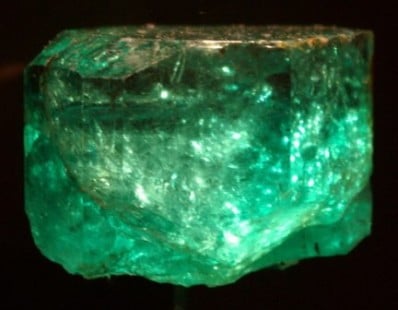The prime consideration for emerald quality comes down to color, more so than for almost any other gemstone. The rarity of large, cleaner emeralds of top color has logically led to sky-rocketing values. The finest emeralds are among the rarest and most valuable gemstones in the world, on par with top rubies, and dwarfing all but the most vivid, natural fancy colored diamonds. But depending on what part of the world in which you are shopping, one thing that can often affect the price of an emerald – either shooting it into the clouds or dropping it into the basement – is its origins.

Emerald from Habach Valley, Austria
The Habachtal in Austria is probably the oldest known source of emeralds and is also the only relevant emerald mine in Europe. The mine is in a high alpine valley, some 6,500+ feet above sea level on extremely steep cliffs not suitable for setting up a stable mine. On top of that, the area is usually cut off by snow and ice for 6 months out of the year.
Emeralds from this mine still pop up from time to time because it is privately owned and operated on a very small scale. Habachtal emeralds are especially sought after by collectors, and they will often command a premium because of their unique origin above and beyond their usually high quality.
“Cleopatra’s Emeralds” came from four primary sources in what was the Upper Kingdom of Ancient Egypt during the last half of the First Millennium BC. These mines were almost completely exhausted centuries ago and were only rediscovered within the last hundred and fifty years. Bedouin tribesmen still come across these emeralds from time to time, but they are unimpressive from a marketing standpoint beyond the novelty of their provenance.

The 858-Carat Gachala Emerald – Colombia
Without a doubt, the finest emeralds of our day have classically come from South America, specifically Colombia. It was likely Francisco Pizarro who originally brought these emeralds back to Europe after conquering Peru in the 1530s, although Hernán Cortés likely encountered gems from the same mines when he conquered Mexico fifteen years prior. Colombian emeralds offer the deepest, purest greens imaginable, but they come with a caveat.
Emerald’s chemical makeup is beryllium aluminum silicate, typically colored by chromium impurities. Beryllium and chromium are almost mutually exclusive in nature; they just do not occur in the same geographic vicinity, almost as a rule. In order to transport beryllium to chromium, the geological events required to form emeralds are cataclysmic. This translates to high levels of damage to a vastly overwhelming majority of emerald rough.
Internal fractures and cavities, feathers, and others kinds of eye-visible inclusions are present in virtually every emerald that is cut, especially in Colombian emeralds. For years, it was simply accepted that it was impossible to find a flawless emerald. Even the very highest clarity grades had some kind of loupe-visible inclusions in them.
Then things changed. The criteria of what makes an emerald an emerald came under fire after a large find of green beryl in Brazil in the early 1960s. Few were of comparable color to Colombian emeralds (at the time), but these stones had one thing to their credit as emeralds.
For decades, emeralds were discerned from their imitators by the presence of chromium, which is primarily responsible for the color of Colombian emeralds. The Brazilian material was colored by vanadium and possessed only the merest traces of chromium – but the chromium was still there. These were far less included and threatened to seriously cut into Colombia’s corner on the emerald market. In 1963, the Gemological Institute of America released its first lab report referring to vanadium-bearing beryl of appropriate color and tone as “emeralds.”

Zambian Emerald
Further complicating the situation, in 1976, Zambia began large-scale mining of fine, rich green beryl colored primarily by vanadium and high percentages of iron, giving a majority of these stones a much stronger bluish hint to their green. These stones were even cleaner than the Brazilian material. Eye-visible inclusions became easier to avoid, and some were found to be loupe-clean. It is estimated that Zambian emeralds now represent up to 20% of the world’s production.
To this day, in spite of new finds of some Brazilian and Zambian stones of color rivaling Colombian material, some countries in Europe refuse to acknowledge beryl colored by anything other than chromium as an emerald. They refer to them as “vanadium emeralds,” or even “American emeralds.” The point is: even the experts can’t agree. If you’re shopping in the US, the chromophores do not matter. An emerald is an emerald based on its depth of color.
With the value of fine emeralds having been established, it is meet to say most emeralds are not out of reach for the limited budget. As noted before, virtually all emeralds are included, and top color is rare enough that unless you specifically ask for it, you probably won’t see it. That having been said, typical fine-grade emeralds still possess captivating greens; you’ll most likely see lots of Zambian and Brazilian material or more heavily included Colombian stones in your average fine jewelry store down the street.
Tags: Austria, beryl, beryllium aluminum silicate, chromium, Colombia, emeralds, europe, fine jewelry, gemstones, Hernán Cortés, South America